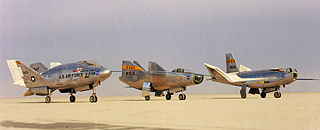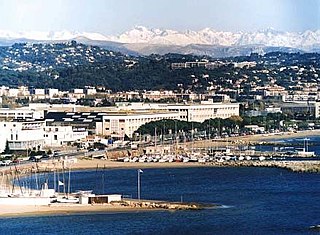
A lifting body is a fixed-wing aircraft or spacecraft configuration in which the body itself produces lift. In contrast to a flying wing, which is a wing with minimal or no conventional fuselage, a lifting body can be thought of as a fuselage with little or no conventional wing. Whereas a flying wing seeks to maximize cruise efficiency at subsonic speeds by eliminating non-lifting surfaces, lifting bodies generally minimize the drag and structure of a wing for subsonic, supersonic and hypersonic flight, or spacecraft re-entry. All of these flight regimes pose challenges for proper flight safety.

Hermes was a proposed spaceplane designed by the French Centre National d'Études Spatiales (CNES) in 1975, and later by the European Space Agency (ESA). It was superficially similar to the American Boeing X-20 Dyna-Soar and the larger Space Shuttle.

A spaceplane is a vehicle that can fly and glide like an aircraft in Earth's atmosphere and maneuver like a spacecraft in outer space. To do so, spaceplanes must incorporate features of both aircraft and spacecraft. Orbital spaceplanes tend to be more similar to conventional spacecraft, while sub-orbital spaceplanes tend to be more similar to fixed-wing aircraft. All spaceplanes to date have been rocket-powered but then landed as unpowered gliders.

Skylon is the name given to a series of concept designs for a reusable single stage to orbit spaceplane by the British company Reaction Engines Limited (Reaction), using SABRE, a combined-cycle, air-breathing rocket propulsion system. The vehicle design is for a hydrogen-fuelled aircraft that would take off from a purpose-built runway, and accelerate to Mach 5.4 at 26 kilometres (85,000 ft) altitude using the atmosphere's oxygen before switching the engines to use the internal liquid oxygen (LOX) supply to take it into orbit. It could carry 17 tonnes (37,000 lb) of cargo to an equatorial low Earth orbit (LEO); up to 11 tonnes (24,000 lb) to the International Space Station, almost 45% more than the capacity of the European Space Agency's Automated Transfer Vehicle; or 7.3 tonnes (16,000 lb) to Geosynchronous Transfer Orbit (GTO), over 24% more than SpaceX Falcon 9 launch vehicle in reusable mode. The relatively light vehicle would then re-enter the atmosphere and land on a runway, being protected from the conditions of re-entry by a ceramic composite skin. When on the ground, it would undergo inspection and necessary maintenance, with a turnaround time of approximately two days, and be able to complete at least 200 orbital flights per vehicle.

SABRE is a concept under development by Reaction Engines Limited for a hypersonic precooled hybrid air-breathing rocket engine. The engine is being designed to achieve single-stage-to-orbit capability, propelling the proposed Skylon spaceplane to low Earth orbit. SABRE is an evolution of Alan Bond's series of LACE-like designs that started in the early/mid-1980s for the HOTOL project.
Hopper was a proposed European Space Agency (ESA) orbital spaceplane and reusable launch vehicle. The Hopper was a FESTIP system study design.

The Advanced Reentry Demonstrator (ARD) was a European Space Agency (ESA) suborbital reentry vehicle. It was developed and operated for experimental purposes, specifically to validate the multiple reentry technologies integrated upon it and the vehicle's overall design, as well as to gain greater insight into the various phenomenon encountered during reentry.

The Intermediate eXperimental Vehicle (IXV) is a European Space Agency (ESA) experimental suborbital re-entry vehicle. It was developed to serve as a prototype lifting body orbital return vehicle to validate the ESA's work in the field of reusable orbital return vehicles.

The Crew Return Vehicle (CRV), sometimes referred to as the Assured Crew Return Vehicle (ACRV), was a proposed dedicated lifeboat or escape module for the International Space Station (ISS). A number of different vehicles and designs were considered over two decades – with several flying as developmental test prototypes – but none became operational. Since the arrival of the first permanent crew to the ISS in 2000, the emergency return capability has been fulfilled by Soyuz spacecraft and, more recently, SpaceX's Crew Dragon – each rotated every 6 months.
Avatar is a concept study for a robotic single-stage reusable spaceplane capable of horizontal takeoff and landing, by India's Defence Research and Development Organisation. The mission concept is for low cost military and commercial satellite space launches.

Thales Alenia Space is a Franco-Italian aerospace manufacturer specialising in the space industry. It is the largest satellite manufacturer based in Europe.
The Future Launchers Preparatory Programme (FLPP) is a technology development and maturation programme of the European Space Agency (ESA). It develops technologies for the application in future European launch vehicles (launchers) and in upgrades to existing launch vehicles. By this it helps to reduce time, risk and cost of launcher development programmes.
Started in 2004, the programmes initial objective was to develop technologies for the Next Generation Launcher (NGL) to follow Ariane 5. With the inception of the Ariane 6 project, the focus of FLPP was shifted to a general development of new technologies for European launchers.
FLPP develops and matures technologies that are deemed promising for future application but currently do not have a sufficiently high technology readiness level (TRL) to allow a clear assessment of their performance and associated risk. Those technologies typically have an initial TRL of 3 or lower. The objective is to raise the TRL up to about 6, thus creating solutions which are proven under relevant conditions and can be integrated into development programmes with reduced cost and limited risk.

The Airbus Defence and Space Spaceplane, also called EADS Astrium TBN according to some sources, is a suborbital spaceplane concept for carrying space tourists, proposed by EADS Astrium, the space subsidiary of the European consortium EADS. A full-size mockup was officially unveiled in Paris, France, on June 13, 2007, and is now on display in the Concorde hall of the Musée de l'Air et de l'Espace. The project is the first space tourism entry by a major aerospace contractor.
Project 921-3 is a crewed spacecraft sub-system of Project 921. The term 921-3 is often used for the Chinese spaceplane program.

Hypersonic flight is flight through the atmosphere below altitudes of about 90 km at speeds greater than Mach 5, a speed where dissociation of air begins to become significant and high heat loads exist. Speeds of Mach 25+ have been achieved below the thermosphere as of 2020.
Reusable Launch Vehicle–Technology Demonstration Programme is a series of technology demonstration missions that has been conceived by the Indian Space Research Organisation (ISRO) as a first step towards realising a Two Stage To Orbit (TSTO) re-usable launch vehicle.

Saenger or Sänger was a West German concept design for a two-stage-to-orbit spaceplane. It is named after Eugen Sänger, who had been a key figure in the development of the concept for aerospace company Junkers.
The Programme for Reusable In-orbit Demonstrator in Europe (PRIDE) is an Italian Space Agency programme that aims to develop a reusable robotic spaceplane named Space Rider in collaboration with the European Space Agency.

The Space Rider is a planned uncrewed orbital lifting body spaceplane aiming to provide the European Space Agency (ESA) with affordable and routine access to space. Contracts for construction of the vehicle and ground infrastructure were signed in December 2020. Its expected maiden flight is in the fourth quarter of 2023.












